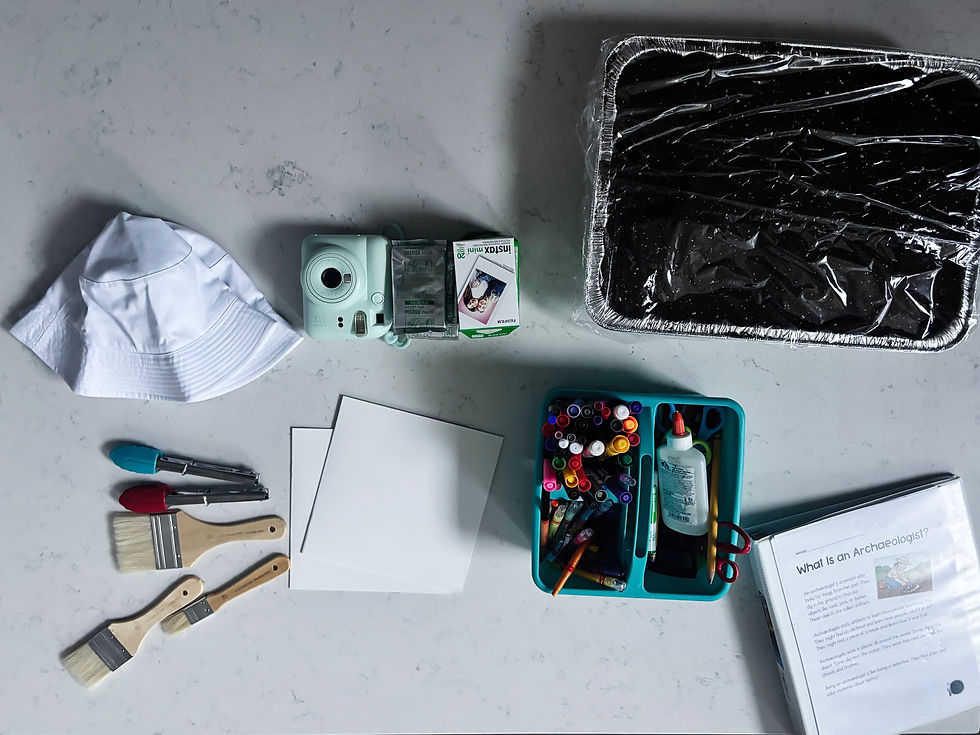Digging Into Learning: A Hands-On Archaeology Mini Unit for Grades 1–3
- tindallamanda
- Oct 24
- 3 min read
Updated: Oct 26

Hey there, educators! 👋 If you’re looking for an engaging and hands-on unit study on Archaeology, you’ve come to the right place!
My daughter has always been fascinated by archaeology, so I wanted to bring that curiosity into our homeschool studies. I originally designed this mini unit for 1st grade, but it can easily be adapted for grades 2–4 as well. Below, you’ll find a full breakdown of each lesson, along with the materials and standards that align with this unit.
Step 1: Dig Simulation
To kick things off, I wanted to get the kids excited and fully immersed in the experience. I set up a mini archaeological dig complete with hats, brushes, and hidden “artifacts” buried in dirt. Before digging, we talked about how archaeologists work carefully and patiently—since artifacts can be fragile and easily damaged.
Once they were ready, the kids began to dig and uncover each hidden item. Every discovery was photographed with a Polaroid camera, just like real archaeologists documenting their finds! When all items were uncovered, we headed back to the “lab” for further investigation.
For our dig, I used a plastic ice cream set as the artifacts. When our dig wrapped up, we celebrated our hard work with real ice cream—a sweet reward! You can, of course, choose any small items that fit your theme; I just recommend avoiding “bones” to prevent confusion with paleontology.
Back in the lab, the students used their photos and notes to record their findings in archaeologist journals- I used blank notebooks like these. They labeled, described, and hypothesized what each artifact might have been used for. This step encourages critical thinking, writing practice, and sentence structure development—all while having fun.
Materials Needed:
Artifacts (small toys, themed items, etc.)
💡 Full disclosure: it gets messy! Dress your little archaeologists accordingly and keep plenty of wipes nearby.
Step 2: Educational Video
Next, we watched Solving Mysteries with Archaeologists! from SciShow Kids—a great introduction to what archaeologists do. Afterward, we discussed the key vocabulary and concepts mentioned in the video.
(Note: I’m not affiliated with SciShow Kids—I just found their video helpful!)
Step 3: “What Is an Archaeologist?” – Nonfiction Passage
After watching the video, we moved into reading “What Is an Archaeologist?”, a nonfiction passage that explains what archaeologists do and how they study the past. It includes a vocabulary list, multiple-choice and short-answer questions, and a creative drawing prompt for students to imagine themselves as archaeologists.
This activity supports reading comprehension, vocabulary building, and inference-making. We also discussed the features that make this text nonfiction.
Step 4: “Dr. Rosa’s Big Discovery” – Fiction Passage
Next, we read “Dr. Rosa’s Big Discovery,” a fictional story about an archaeologist who makes an exciting find during a dig. Like the previous activity, it includes comprehension questions and reflection prompts, encouraging students to connect the story to their own lives.
We also talked about how, even though the story felt realistic, it was still fictional—introducing the idea of realistic fiction in a fun, accessible way.

Step 5: Compare and Contrast
To tie both texts together, we used a Venn diagram to compare and contrast the nonfiction and fiction passages. This helped students identify key differences in structure and purpose, while noticing overlapping themes and details.
Both passages and the Venn diagram are part of my Archaeology Mini Unit.

Step 6: Pottery Making
To celebrate the completion of our unit, we made our own pottery! I used this beginner pottery kit that came with all the necessary tools. It was messy, took a few tries, and brought lots of laughter—but the kids loved it! This was a wonderful hands-on extension that let them experience what ancient artisans might have done.
Mini Unit Timeline
Here’s how we paced our lessons—feel free to adjust as needed for your classroom or homeschool:
Day 1: Dig Simulation
Day 2: Archaeologist Video + “What Is an Archaeologist?”
Day 3: “Dr. Rosa’s Big Discovery”
Day 4: Compare & Contrast + Pottery Making
Bonus: Recommended Read-Alouds
Looking to expand the unit? Here are a few great read-alouds to pair with your lessons:
Archaeologists Dig for Clues – A nonfiction picture book that explains how archaeologists dig and what they look for. Perfect for Grades 1–3.
What Is an Archaeologist? (National Geographic Kids) – A Level 3 reader with strong visuals and global context, ideal for 1st–2nd graders ready for a challenge.
Dig It!: Archaeology for Kids – A bit more advanced (ages 8–16), but great for read-aloud discussions or select excerpts.
This Archaeology Mini Unit was one of our favorites! It combined reading comprehension, vocabulary, writing, and science—all wrapped in a creative, hands-on experience. Whether you’re teaching in a classroom or homeschooling, your students will love exploring the world of archaeology through discovery and imagination.
































Comments